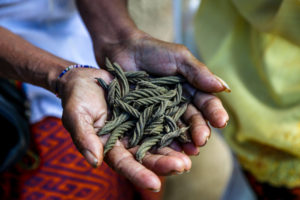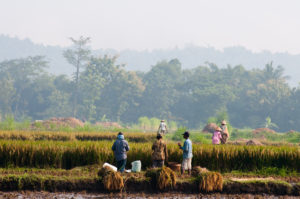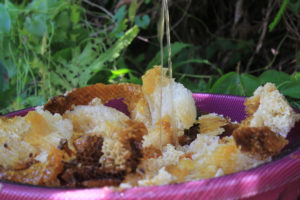
Scientists in Indonesia are demonstrating how better business opportunities for local communities can help foster and reinforce sustainable forest management.
As the world marks International Day of Forests on March 21, the benefits of reforestation and forest restoration are rightly lauded. In success stories of the past, local communities have often been cast as the heroes of sustainable forestry, while private sector businesses have been portrayed as villains. But what if that’s not the whole story?
The Kanoppi project, which launched in 2013 and has now entered its second phase, concentrates on the expansion of market-based agroforestry and the development of integrated landscape management in the poorest provinces of eastern Indonesia and the country’s most densely-populated island of Java.
The project, which is part of the CGIAR Research Program on Forests, Trees and Agroforestry (FTA), is funded by the Australian Centre for International Agricultural Research (ACIAR) and led by scientists from the World Agroforestry (ICRAF), Center for International Forestry Research (CIFOR), the Research, Development and Innovation Agency (FOERDIA) of the Indonesian Ministry of Environment and Forestry and Murdoch University in collaboration with other project partners.
Read also: New children’s book teaches the sustainable traditions of West Timorese honey hunters
Missing link
For many generations, communities living in Indonesia have relied on forests to supplement the food and income they reap from farming. Yet, despite the riches of the forests, poverty is still widespread. Some rural households living in the Kanoppi project’s pilot sites in eastern Indonesia earn around US$210 a year.
Part of the challenge is a lack of integration and linkages between community groups producing timber and non-timber forest products (NTFP) and the private sector. Conflicting, confusing and changeable public policies also do not help.
“For example, some communities will plant small teak plantations as a kind of savings account, but most don’t know how to get the permits required to harvest and transport the timber,” explained Ani Adiwinata Nawir, policy scientist with CIFOR. “This means that communities do not harvest as much teak as they could and that they can’t convert their timber into cash when needed.”
Strengthening value chains has become a key focus for Kanoppi, so that farmers can capture more value from their agroforestry production. This, however, requires sustained efforts at multiple levels, including promoting better practices on the ground to increase productivity and profitability, developing markets and private sector engagement, and facilitating supportive policies and institutions.

Protecting the forest
One example of how to turn traditional community practices into a successful business venture comes from the Mount Mutis Nature Reserve in West Timor. Here, communities come together every year to harvest wild forest honey. The task is dangerous – men scale trees of up to 80 meters to collect the honey by hand – but it is also sustainable because it does not require cutting down trees.
The honey supplements local diets, and there is enough left over to sell. In fact, as much as 30 tons of wild honey is produced and harvested in Mt. Mutis annually, accounting for 25 percent of total production in the province. Working collaboratively with WWF Indonesia – which is one of the project’s NGO partners along with others like Threads of Life – Kanoppi has helped brand and package the honey, which is now sold as “Mt. Mutis honey” and sold to neighboring islands.
Similarly on Sumbawa island, this commercial success is good news for communities and for the forest: Because the continued honey production hinges on a healthy ecosystem, people have a strong economic incentive to preserve and protect the forest.
That’s the underlying logic of the whole project. When communities can successfully market and sell sustainable products, their incentive to continue sustainable forestry practices grows, which in turn increases productivity, profitability and incomes.
“We want to reinforce this virtuous cycle where business opportunities foster sustainable forestry,” said Aulia Perdana, a marketing specialist with ICRAF. “That’s why we try to involve the private sector – for example in the village learning centers we’ve established in project sites – so that communities can better connect with the market.”
Other efforts to promote sustainable and profitable agroforestry production include using voluntary extensionists, meaning that the people who first adopt a new technology help spread those innovations to other members of the community. Eleven on-farm demonstration trials have already been established, and 40 more are planned for 2019. Kanoppi has also published manuals, journal articles, videos and a picture book to promote its methodology.
Read the picture book: Secrets of the Mutis Honey Hunters
Landscape perspective
Given the project’s success with marketing the sustainably produced honey from Mt. Mutis, the local district administration has adapted its strategy on integrated landscape-level management of NTFP to give greater weight to communities’ customary practices. This is an important first step toward establishing policy support elsewhere in the country.

One challenge has been that past planning and policies have separately focused on different sectors, such as small farms in forestry and target-oriented cash crop production led by other sectors – not considering opportunities for synergies or problematic overlaps. Kanoppi has departed from that approach.
“We talk about integrated landscape management, which essentially is about harmonizing the different land uses along the watershed from upstream to downstream, so that farms, plantations, forests and many other kinds of activities coexist and reinforce each other,” said Ani.
“The landscape perspective helps everyone – communities, businesses and authorities – see what kind of production fits where in the landscape, in ways that are both profitable and sustainable.”
Kanoppi is a clear example of how combining the expertise and experience of CIFOR and ICRAF scientists makes for a strong response to development and sustainability challenges in forested landscapes – among the many reasons why the two institutions recently announced a merger.
In Indonesia, Ani, Perdana and their colleagues will continue their work to develop inclusive, sustainable business models that generate a fair return – specifically focusing on scaling-up the adoption of improved production practices and value chains to benefit smallholder livelihoods through landscape-scale management of the farm-forest interface – for communities and for forests.
By Marianne Gadeberg, communications specialist.
This research is part of the CGIAR Research Program on Forests, Trees and Agroforestry (FTA). FTA is the world’s largest research for development program to enhance the role of forests, trees and agroforestry in sustainable development and food security and to address climate change. CIFOR leads FTA in partnership with Bioversity International, CATIE, CIRAD, INBAR, ICRAF and TBI. FTA’s work is supported by the CGIAR Trust Fund.











